Treasure Planet
7 /10 1 Votes
Country United States | 7/10 IMDb Genre Animation, Adventure, Family Featured song Always Know Where You Are Duration Language English | |||||||||||||||||||||||||||||||||
 | ||||||||||||||||||||||||||||||||||
Release date November 27, 2002 (2002-11-27) Writer Robert Louis Stevenson (novel), Ron Clements (screenplay), John Musker (screenplay), Rob Edwards (screenplay), Ron Clements (animation story), John Musker (animation story), Ted Elliott (animation story), Terry Rossio (animation story) Cast (Jim Hawkins), (Dr. Delbert Doppler), (Captain Amelia), (Mr. Arrow), (B.E.N.), (Sarah Hawkins) Similar movies Lara Croft: Tomb Raider , Raiders of the Lost Ark , Lara Croft Tomb Raider: The Cradle of Life , National Treasure , Indiana Jones and the Last Crusade , Indiana Jones and the Temple of Doom Tagline Find your place in the universe. | ||||||||||||||||||||||||||||||||||
Treasure planet 2002 official trailer 1 animated movie hd
Treasure Planet is a 2002 American animated science fiction film produced by Walt Disney Feature Animation and released by Walt Disney Pictures on November 27, 2002. It is the 43rd Disney animated feature film. The film is a science fiction adaptation of Robert Louis Stevenson's adventure novel Treasure Island and was the first film to be released simultaneously in regular and IMAX theaters. The film employs a novel technique of hand-drawn 2D traditional animation set atop 3D computer animation.
Contents
- Treasure planet 2002 official trailer 1 animated movie hd
- original cut hd treasure planet i m still here english
- Plot
- Cast
- Development
- Writing
- Casting
- Design and animation
- Audio
- Marketing
- Release
- Critical response
- Box office
- Awards
- Cancelled sequel
- Video games
- Reception
- References
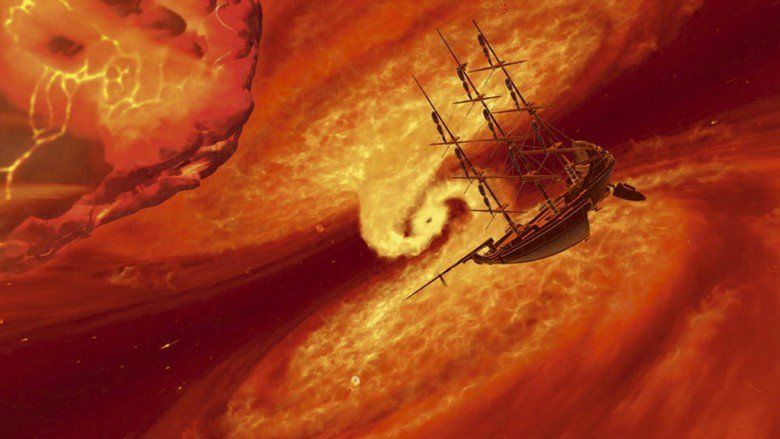
The film was co-written, co-produced and directed by Ron Clements and John Musker, who had pitched the concept for the film at the same time that they pitched Disney's other animated feature The Little Mermaid (1989), the film is also an animated remake of the 1987 Italian mini-series Treasure Island in Outer Space. Treasure Planet features the voices of Joseph Gordon-Levitt, Brian Murray, David Hyde Pierce, Martin Short, Roscoe Lee Browne, Emma Thompson, Laurie Metcalf, and Patrick McGoohan (in his final film role). The musical score was composed by James Newton Howard, while the songs were written and performed by John Rzeznik. Despite positive critical reception, the film bombed in the United States box office, costing $140 million to create while earning $38 million in the United States and Canada and just shy of $110 million worldwide. It was nominated for the 2002 Academy Award for Best Animated Feature.
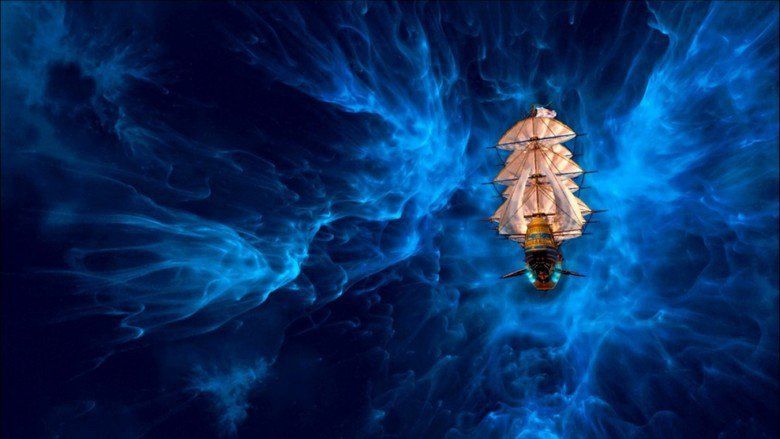
original cut hd treasure planet i m still here english
Plot

On the planet Montressor, a young Jim Hawkins is enchanted by stories of the legendary pirate Captain Nathaniel Flint and his ability to appear from nowhere, raid passing ships, and disappear in order to hide the loot on the mysterious "Treasure Planet". Twelve years later, Jim has grown into an aloof and isolated teenager. He reluctantly helps his mother Sarah run the family's Benbow Inn, and derives amusement from "Alponian solar cruising", skysurfing atop a rocket-powered sailboard.
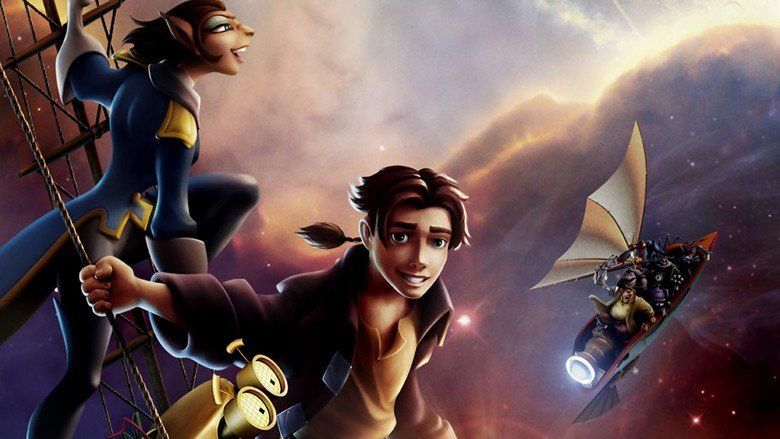
One day, a spaceship crashes near the inn. The dying pilot, Billy Bones, gives Jim a sphere and tells him to "beware the cyborg". After this, a gang of pirates raid and burn the inn. Jim, his mother, and their dog-like friend Dr. Delbert Doppler flee. At Doppler's study, Jim finds that the sphere is a holographic projector, showing a star map that leads to the location of Treasure Planet.

Doppler commissions a ship called the RLS Legacy, on a mission to find Treasure Planet. The ship is commanded by the cat-like Captain Amelia along with her stone-skinned and disciplined first mate, Mr. Arrow. The crew is a motley bunch, secretly led by the half-robot cook John Silver, whom Jim suspects is the cyborg he was warned about. Jim is sent down to work in the galley, where he is supervised by Silver and his shape-shifting pet, Morph. Despite Jim's mistrust of Silver, they soon form a tenuous father-son relationship. Flashbacks are shown in Jim's youth when his father abandoned him.
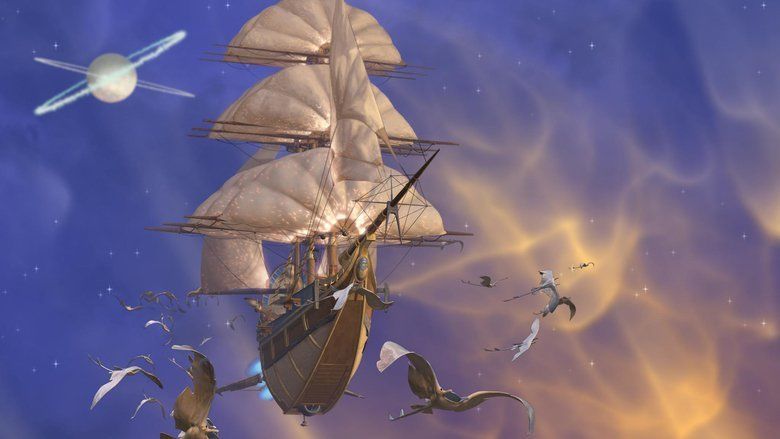
During the voyage, the ship encounters a supernova. Jim, while securing lifelines of all crew members, saves Silver from falling just in time. The supernova then devolves into a black hole, where Arrow falls. The burst of shock waves and maximum engine power enable Amelia to pilot the ship to safety. Amelia mourns the loss of Arrow, and suspects Jim of failing to secure the lifelines, while in fact Arrow's line was cut by a ruthless insectoid crew member named Scroop.
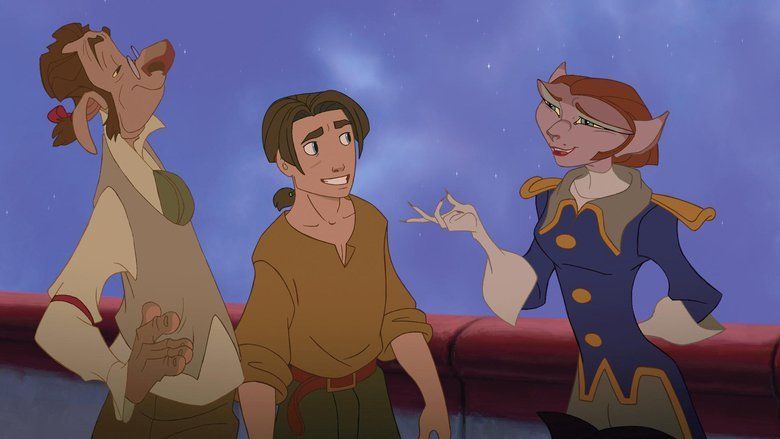
As the ship reaches Treasure Planet, Jim overhears that the crew are pirates, and mutiny erupts. Jim, Doppler, Amelia, and Morph abandon the ship, but Morph has left the map behind. Thinking that Jim has the map, Silver has a chance to blast Jim, but hesitates because of his attachment to the boy. The fugitives are shot down by a mutineer during their escape, injuring Amelia.
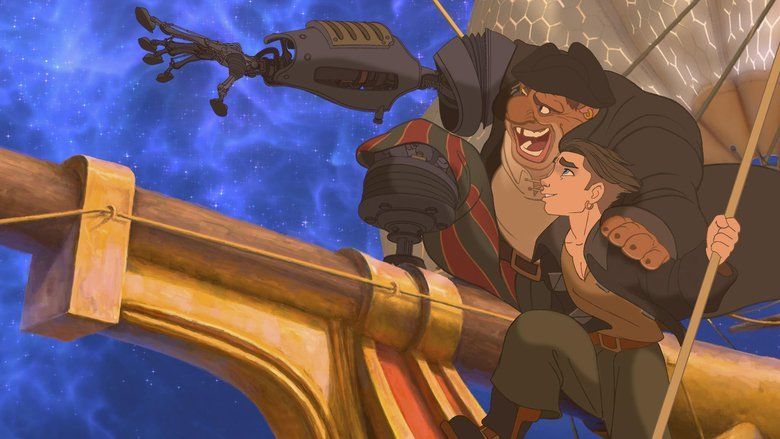
While exploring Treasure Planet's forests, the fugitives meet B.E.N., an abandoned robot, who says he has literally lost his primary memory and invites them to his place for shelter. The pirates corner the group here; using a back-door, Jim, B.E.N. and Morph return to the ship in an attempt to recover the map. Scroop attacks them but gets drifted into space. They obtain the map, however, on return, they are caught by Silver, who already captured Doppler and Amelia.
Silver forces Jim to use the map, directing them to a portal that opens on any location in the universe, which Jim realizes is how Flint conducted his raids. They open the portal to the center of Treasure Planet, discovering that the planet is really a space station built eons ago that Flint commandeered to stow his treasure. As the pirates prepare to collect the loot, Jim finds the skeletal remains of Flint, holding the missing component to B.E.N.'s cognitive computer. He reinserts it, and B.E.N. immediately recalls that Flint rigged the planet to explode upon the treasure's discovery. As the planet begins to fall apart, Silver, trying to hold onto a boat-load of gold, opts to let it go to save Jim. The survivors escape to the Legacy, which is damaged and unable to leave the planet in time. Jim rigs a makeshift rocket-powered sailboard, and rides ahead of the Legacy towards the portal. At the last moment, Jim sets the portal to Montressor Spaceport, and both he and the Legacy safely clear the destruction.
Jim finds Silver has snuck below decks to escape. He allows him to go, and Silver asks him to keep Morph, as well as providing him some part of the treasure to rebuild the Benbow Inn, believing Jim will "rattle the stars". Amelia offers Jim a recommendation to Intersteller Academy before returning to the spaceport to reunite with his mother. Sometime later, a party is hosted at the rebuilt inn, where Doppler and Amelia are married, have children of their own, and Jim becomes a military cadet. Jim looks into the skies and sees an image of Silver in the clouds.
Cast
Development
Treasure Planet took roughly four and a half years to create, but the concept for Treasure Planet (which was called Treasure Island in Space at the time) was originally pitched by Ron Clements in 1985 during the meeting wherein he and John Musker also pitched The Little Mermaid. Clements stated that Jeffrey Katzenberg, who was the chief of Walt Disney Studios at the time, "just wasn't interested" in the idea. Since Musker and Clements wanted to be able to move "the camera around a lot like Steven Spielberg or James Cameron," the delay in production was beneficial since "the technology had time to develop in terms of really moving the camera." Principal animation for the film began in 2000 with roughly 350 crew members working on it. In 2002, Roy Conli estimated that there were around 1,027 crew members listed in the screen credits with "about four hundred artists and computer artists, about a hundred and fifty musicians and another two hundred technologists".
According to Conli, Clements wanted to create a space world that was "warm and had more life to it than you would normally think of in a science fiction film", as opposed to the "stainless steel, blue, smoke coming from the bowels of heavily pipe laden" treatment of science fiction. In order to make the film "fun" by creating more exciting action sequences and because they believed that having the characters wear space suits and helmets "would take all the romance out of it", the crew created the concept of the "Etherium," an "outer space filled with atmosphere".
Several changes were made late in the production to the film. The prologue of the film originally featured an adult Jim Hawkins narrating the story of Captain Flint in first person, but the crew considered this to be too "dark" and felt that it lacked character involvement. The crew also intended for the film to include a sequence showing Jim working on his solar surfer and interacting with an alien child, which was intended to show Jim's more sensitive side and as homage to The Catcher in the Rye. Because of the intention to begin the film with a scene of Jim solar surfing, the sequence had to be cut.
Writing
Writer Rob Edwards stated that "it was extremely challenging" to take a classic novel and set it in outer space, and that they did away with some of the science fiction elements ("things like the metal space ships and the coldness") early on. Edwards goes on to say that they "did a lot of things to make the film more modern" and that the idea behind setting the film in outer space was to "make the story as exciting for kids now as the book was for kids then".
With regard to adapting the characters from the book to film, Ron Clements mentioned that the Jim Hawkins in the book is "a very smart, very capable kid", but they wanted to make Jim start out as "a little troubled kid" who "doesn't really know who he is" while retaining the aforementioned characteristics from the original character. The "mentor figures" for Jim Hawkins in the novel were Squire Trelawney and Dr. Livesey, whom John Musker described as "one is more comic and the other's very straight"; these two characters were fused into Dr. Doppler. Clements also mentions that though the father-son relationship between Jim Hawkins and John Silver was present "to some degree" in the book, they wanted to emphasize it more in the film.
Casting
Casting director Ruth Lambert held a series of casting auditions for the film in New York, Los Angeles, and London, but the crew already had some actors in mind for two of the major characters. The character of Dr. Doppler was written with David Hyde Pierce in mind, and Pierce was given a copy of the Treasure Planet script along with preliminary sketches of the character and the film's scenic elements while he was working on Pixar's A Bug's Life (1998). He stated that "the script was fantastic, the look was so compelling" that he accepted the role. Likewise, the character of Captain Amelia was developed with the idea that Emma Thompson would be providing her voice. "We offered it to her and she was really excited," Clements said. Musker said, "This is the first action adventure character that Emma has ever played and she was pregnant during several of the sessions. She was happy that she could do all this action and not have to train for the part" There were no actors initially in mind for the characters of John Silver and Jim Hawkins; Brian Murray (John Silver) and Joseph Gordon-Levitt (Jim Hawkins) were signed after months of auditions. Gordon-Levitt stated that he was attracted to the role because "it's a Disney animated movie and Disney animated movies are in a class by themselves," and that "to be part of that tradition is unbelievable to me". Musker mentioned that Gordon-Levitt "combined enough vulnerability and intelligence and a combination of youthfulness but incompleteness" and that they liked his approach.
Among the lead actors, only Pierce had experience with voice acting prior to the making of Treasure Planet. Conli explained that they were looking for "really the natural voice of the actor", and that sometimes it was better to have an actor with no experience with voice work as he utilizes his natural voice instead of "affecting a voice". The voice sessions were mostly done without any interaction with the other actors, but Gordon-Levitt expressed a desire to interact with Brian Murray because he found it difficult to act out most of the scenes between Jim Hawkins and John Silver alone.
Design and animation
While designing for Treasure Planet, the crew operated on rule they call the "70/30 Law" (an idea that art director Andy Gaskill has credited to Ron Clements), which meant that the overall look of the film's artwork should be 70% traditional and 30% sci-fi. The overall look of Treasure Planet was based on the art style promoted by illustrators associated with the Brandywine School of Illustration (such as Howard Pyle and N.C. Wyeth), whose illustrations have been described by the film's crew as being the "classic storybook illustration," having a painterly feel to it, and being composed of a warm color palette. The animators took Deep Canvas, a technology which they had initially developed for Tarzan (1999), and came up with a process they called "Virtual Sets," wherein they created entire 360 degree sets before they began staging the scenes. They combined this process with traditionally-drawn characters in order to achieve a "painted image with depth perception" and enabled the crew to place the camera anywhere in the set and maneuver it as they would maneuver a camera for a live-action film. In order to test how a computer-generated body part (specifically John Silver's cyborg arm) would mesh with a traditionally animated character, the crew took a clip of Captain Hook from Peter Pan and replaced his arm with the cyborg arm.
There were around forty animators on the crew, and were further divided into teams; for example, sixteen animators were assigned to Jim Hawkins because he appeared on the screen the most, and twelve were assigned to John Silver. To ensure "solidity" in illustration and personality, each major character in the film had a team of animators led by one supervisor. Conli mentioned that the personalities of the supervisors affect the final character, citing Glen Keane (the supervisor for John Silver) as well as John Ripa (the supervisor for Jim Hawkins) as examples. The physical appearance, movements, and facial expressions of the voice actors were infused into the characters as well.
When asked if they drew inspiration from the previous film adaptations of Treasure Island for the character designs, Glen Keane stated that he disliked looking at previous portrayals of the character in order to "clear his mind of stereotypes", but that he drew some inspiration for the manner by which Silver spoke from actor Wallace Beery, whom he "loved because of the way he talked out of the side of his mouth." For the characterization and design for Jim Hawkins, John Ripa cited James Dean as an important reference because "there was a whole attitude, a posture" wherein "you felt the pain and the youthful innocence", and he also cited the film Braveheart because "there are a lot of close-ups on characters...who are going through thought processes, just using their eyes."
Animators also used maquettes, small statues of the characters in the film, as references throughout the animation process. Character sculptor Kent Melton mentioned that the first Disney film to use maquettes was Pinocchio (1940), and that this paved the way to the formation of an entire department devoted to character sculpting. Keane noted that maquettes are not just supposed to be "like a mannequin in a store", but rather has to be "something that tells you [the character's] personality" and that maquettes also helped inspire the way actors would portray their roles.
Audio
This "70/30 Law" was not only applied to the visual designs for the film, but also for the sound effects and music. Sound designer Dane Davis mentioned that he and his team "scoured hobby shops and junk stores for antique windup toys and old spinning mechanisms" in order to create the sound effects for John Silver to "avoid sounding slick or sci-fi". The team did some experimentation with the sound used in dialogues, especially with the robot B.E.N., but opted to keep Short's natural voice because everything they tried "affected his comedy", and "the last thing you want to do in a story like this is affect performances".
The music from the film is largely orchestral in nature, although it includes two moderately successful pop singles ("I'm Still Here" and "Always Know Where You Are") from The Goo Goo Dolls frontman John Rzeznik and British pop-rock group, BBMak. Both songs were written and performed by John Rzeznik in the film, but BBMak recorded "Always Know Where You Are" for the soundtrack. The score was composed by James Newton Howard, who said that the score is "very much in the wonderful tradition of Korngold and Tiomkin and Steiner." The score has been described as a mixture of modern music in the spirit of Star Wars and Celtic music. Scottish fiddler Alasdair Fraser is credited as the co-composer of the track "Silver Leaves", and is also listed as a soloist in the film's credits. Walt Disney Records released the film's soundtrack album on November 19, 2002.
Marketing
Prior to and during its theatrical run, Treasure Planet had promotional support from McDonald's, Pepsi-Cola, Dreyer's, and Kellogg Company. McDonald's included promotional items such as action figures and puzzles in their Happy Meals and Mighty Meals, Pepsi-Cola placed promotional film graphics onto the packaging of a number of their soft drinks (Mountain Dew, Code Red Sierra Mist, Mug Root Beer, Orange Slice, and Lipton Brisk), Dreyer's used their delivery truck panels to promote ice cream flavors inspired by the film (such as "Galactic Chocolate" and "Vanilla Treasure"), and Kellog included film-branded spoons in their cereal boxes. Hasbro also released a line-up of Treasure Planet action figures and toys.
Release
Treasure Planet held its world premiere at the Cinerama Dome in Hollywood on November 17, 2002, though it was also screened in Paris, France on November 6, 2002. The film is "the first major studio feature" to be released in regular and IMAX theaters simultaneously; this was done in the light of the success of Disney films that were re-released in IMAX format, such as Fantasia 2000 and Beauty and the Beast. Dick Cook, then-chairman of Walt Disney Studio Entertainment, also mentioned that the simultaneous release was a good way to distinguish themselves during the competitive holiday season.
Treasure Planet was released in DVD and VHS format in the United States and Canada on April 29, 2003. The DVD includes behind-the-scenes featurettes, a visual commentary, deleted scenes, teaser and theatrical trailers, the music video for the song "I'm Still Here" by John Rzeznik, and a virtual tour of the RLS Legacy. The DVD retained the number one spot in Billboard's top sales for two weeks and the VHS was number one in sales for three weeks. By July 2003, Treasure Planet brought in $64 million in DVD sales.
Disney released a 10th Anniversary special edition Blu-ray/DVD combo on July 3, 2012.
Critical response
The film has a 69% rating on Rotten Tomatoes based on 147 reviews. The site's critical consensus states "Though its characterizations are weaker than usual, Treasure Planet offers a fast-paced, beautifully rendered vision of outer space."
Stephen Hunter of The Washington Post, who gave it 4 stars out of 5, stated that the film "boasts the purest of Disney raptures: It unites the generations, rather than driving them apart". Leah Rozen of People stated that the film "has imagination, humor aplenty and moves briskly", and that "the animation, combining traditional and digital techniques, is ravishing." Claudia Puig of USA Today said that the film's most noteworthy feature is "the artful way it combines the futuristic and the retro", and went on to say that the film doesn't have the "charm of Lilo & Stitch" nor the "dazzling artistry of Spirited Away", but concluded that Treasure Planet is "a capable and diverting holiday season adventure for a family audience." Kim Hollis of Box Office Prophets stated that "there's plenty to recommend the film – the spectacular visuals alone make Treasure Planet a worthwhile watch," though expressing disappointment because she felt that the characters were "not all that creatively rendered".
There were also many who criticized the film. Roger Ebert of the Chicago Sun-Times gave it 2.5 stars out of 4; he felt that a more traditional take on the story would have been "more exciting" and "less gimmicky". Andy Klein of Daily Variety Gotham complained about the script, describing it as "listless" and remarked, "If only its script were as amusing as its visuals." A. O. Scott of The New York Times described the film as "less an act of homage than a clumsy and cynical bit of piracy", and went on to say that it is "not much of a movie at all" and a "brainless, mechanical picture". Owen Gleiberman of Entertainment Weekly described the film as "all cutesy updated fripperies and zero momentum."
Box office
Treasure Planet grossed over $12 million on its debut weekend, ranking at #4 behind Harry Potter and the Chamber of Secrets, Die Another Day, and The Santa Clause 2. The film ended up as an American box office bomb, grossing only $38 million in the United States and Canada and $110 million worldwide. Its failure became apparent early on, as Disney's Buena Vista Distribution arm reduced its fourth-quarter earnings by $47 million within a few days of the film's release. In 2014, the LA Times listed the film as one of the most expensive box office flops of all time.
Awards
The film was nominated for the Academy Award for Best Animated Feature, but lost to Spirited Away (2001). It was also nominated for a number of Annie Awards.
Cancelled sequel
Before Treasure Planet was shown in cinemas, Thomas Schumacher, then-president of Walt Disney Feature Animation, mentioned the possibilities of having direct-to-video releases for Treasure Planet as well as a television series. He stated that they already had "a story and some storyboards and concepts up and a script for what a sequel to [Treasure Planet] could be," and that they also had a "notion" of what the series would be.
Director Jun Falkenstein and screenwriter Evan Spiliotopoulos began early development on Treasure Planet 2. In the sequel, Jim Hawkins and Kate, his love interest and classmate at the Royal Interstellar Academy, must team with Long John Silver to stop the villainous Ironbeard from freeing the inmates of Botany Bay Prison Asteroid. Willem Dafoe was set to voice Ironbeard. The sequel was cancelled when Treasure Planet disappointed at the box office.
Video games
Several Treasure Planet video games were released. Disney Interactive released the naval strategy game Treasure Planet: Battle at Procyon for the PC in October 2002, while Sony Computer Entertainment released a Treasure Planet action video game for the PlayStation and PlayStation 2 in November, developed by Bizarre Creations. The company used Softimage's XSI engine for modeling, texturing and animation, and released a Making-of video on their Facebook page in 2008. A Game Boy Advance game based on the film was also released.
A series of games collectively called Disney's Treasure Planet: Training Academy (or Disney's Treasure Planet Collection) was also released in 2002. It was composed of three games (Broadside Blast, Treasure Racer, and Etherium Rescue), and players with all three games could unlock a fourth game (Ship Shape).
Reception
The game was met with mixed to negative reception upon release. GameRankings and Metacritic gave it a score of 66.43% and 68 out of 100 for the Game Boy Advance version; 64% and 61 out of 100 for the PlayStation 2 version; and 57.14% and 44 out of 100 for the PlayStation version.
References
Treasure Planet WikipediaTreasure Planet IMDb Treasure Planet themoviedb.org
